Author: Erin Bloom
School/Organization:
Wagner Middle School
Year: 2014
Seminar: Native American Voices: The People – Here and Now
Grade Level: 6
Keywords: anthropology, landscape, Native American issues, sacred places
School Subject(s): English, Social Studies
For centuries, Native Americans have experienced an immediate relationship with the landscape. Connecting both physically and spiritually with their natural world, Native people have shaped and continuously defined their identities, their cultures and their unique histories. As related by Duane Champagne in Native American Voices, “Native American history is not just for Indians, it is for all Americans by virtue of our common national identity and our shared connection to our homeland.”
Despite this truism, Native American history is given little attention in the current curriculum of our nation’s elementary, middle and high schools. Students are presented with a Eurocentric view of North American history and the history of our true predecessors is oftentimes tainted or completely removed from study. Thus, when students encounter issues of contemporary Native peoples, they are unable to draw on the prior knowledge necessary to develop a deep understanding of what it means to be Native American and the historical intricacies surrounding the marginalized tribes today.
This unit will provide a means for teaching about Native American culture, specifically in relation to sacred places, in a meaningful way for students, presenting the lesser-known history of our country, as well as providing context for many of the contemporary issues surrounding sacred places. In exploring relevant themes of culture, identity, and place in both primary and secondary texts, students will interact meaningfully with the texts and be prompted to respond to these externalities as a means of comparing their own lives and values to those of Native American cultures. Additionally, students will engage with a variety of texts, both fiction and nonfiction, to develop a more well rounded sense of the issue of Native American sacred places and its complexities, as well as its relevance in today’s society.
Download Unit: Bloom-Erin-unit.pdf
Did you try this unit in your classroom? Give us your feedback here.
Given the lack of curricular focus on contemporary Native American issues, as well as the textbook Eurocentric-skewed history of Native people that students receive in Social Studies, today’s students tend to know very little about Native American culture and the issues that surround it. Without going beyond the basic knowledge of events such as Thanksgiving and the Trail of Tears, and by presenting much of the history and culture of Native people through myth and farce, educators are doing a great disservice to their students. However, in providing students with real context and true accounts of Native American life, both past and present, educators are better able to reach students and aid them in forging the connection between Native American history, contemporary Native culture, and the lives of our urban students. In examining past and current government policies, as well as Native American literature and artifacts, students will gain knowledge of and a greater appreciation for the landscape and its place in Native American life. While there are many texts useful in exploring the themes of Native American culture and sacred places, a few of those examined in this unit include: “Look at Us,” a poem by John Trudell Known as the “people’s poet,” John Trudell is an activist and leader of the American Indian Movement. This poem, from his anthology, Lines from a Mined Mind, compares Native American values to the values of white America. In the poem, Trudell juxtaposes the Native roots in American to the constant need for continued technology and the search for the “new’ in today’s white society. “Sacred Ground,” a poem by Suzan Shown Harjo A poet, activist and the founder of The Morning Star Institute, Suzan Shown Harjo is from the Cheyenne and Hodulgee Muscogee Nations. Her poem “Sacred Ground” describes the landscape in terms of its spiritual power and worth. It is well suited for a lesson personification, particularly for Harjo’s depiction of sacred places has as having human spirits and characteristics. “Treaty Oration of 1854,” a speech by Chief Seattle Although the speech has recently been surrounded in controversy in terms of when and where it was delivered, and if it was in fact delivered by Chief Seattle, its text is a powerful statement on the importance of the land to Native Americans and stands as a lasting testament to conservation and repatriation. The most popular sentiment is that the speech was delivered by Chief Seattle in 1854 in response to the surrendering of Native lands to white settlers. “Indian Removal Act of 1830,” a law written by President Andrew Jackson As a fierce proponent of Indian removal, Andrew Jackson drafted the Indian Removal Act which was passed as a law by Congress on May 28, 1830. The act stated that the President was able to negotiate with Indian nations to forcibly or non-forcibly occupy their lands and eventually led to the relocation of many tribes, as well as to the Trail of Tears. “The Lenape Creation Story,” a creation story as told by Robert Red Hawk In this Lenape creation story, the Great Spirit dreams the landscape, animals and man into creation. The story also tells about the creation of the peace pipe and of the first fire and flood. Unlike the Christian creation story, animals and the landscape are in the forefront of creation. Overall, “Children of the Earth” will be differentiated to address multiple learning levels and learning styles. It will align with the National Common Core standards. Through this curriculum unit, students will use a variety of modalities to read, write, respond to, conduct research, and create works related Native American history, culture, and their intricate ties to the landscape.
This unit is intended for use with students in an inclusive sixth grade Literacy (Reading and Writing) classroom in a middle school setting. Students spend 75-90 minutes daily in Literacy class, with an additional 45 minutes allotted for Project-Based Learning, and one day per week reserved for Writing. By the end of the unit, students will be able to: Beyond the technical level and development of foundational standards, students will also be encouraged to continue to read and to utilize the growing list of related texts as a means of exploring the historical implications of Indian removal from their lands, their cultural ties to the landscape, and contemporary issues involving sacred places. In addition to completing class activities related to each of these standards, students will use the research process and expository writing skills develop their own opinion and understanding of history and its impact on present events.
Throughout the unit, a variety of strategies will be employed to ensure that students are analyzing, internalizing, and fully comprehending the material presented in each lesson. The strategies are used to support all types of learners in the development of their reading, writing, thinking, and listening skills as they relate in Literacy, Social Studies, and across the curriculum. Before, During and After (BDA): BDA strategies will be incorporated in each lesson. The BDA strategy is a variation of the “I Do, We Do, You Do” model of classroom instruction. The strategy allows readers to interact with the text on a level that would not be reached if the teacher merely provided students with answers and explanations of the text. In the “Before” segment of the lesson, the instructor briefly introduces new materials and models how to perform activities. In the “During” segment of the lesson, students interact with the text by creating marginalia and asking questions of the text. In the “After” segment, students respond to the text in a variety of ways including analysis of the text in both written response or through the completion of comprehension questions. Do Now: The “Do Now” functions tri-fold in my classroom. It occurs as part of the “Before” segment of the lesson. The “Do Now” is used to grab the students’ attention at the beginning of class, access prior knowledge about the topic at hand, and prepare them to consider the day’s objectives and material. Each day, the “Do Now” occurs as soon as students enter the classroom. Each “Do Now” lasts five minutes and is awarded five points for completion and participation. Because it happens as soon as students enter the classroom and is immediately awarded points, it holds students accountable for their class work and participation from the onset of the class period. The “Do Now” will be used throughout the unit in all three ways described above. Text Rendering: Text rendering occurs during the “During” portion of the lesson. To complete text-rendering tasks, students underline, highlight and create marginalia for a given text. Text rendering is particularly useful for teaching students to interact with a text and to practice meta-cognition. In my class, student highlight key phrases and ideas, underline new vocabulary terms, and circle items that they have a question about. Text rendering is a skill that must be modeled by the educator in order to have students practice it effectively. Choice Boards: Choice Boards are a differentiation tool that give students options as to which activities they would like to complete during a given class duration. The boards are set up to include skill sets that the students have learned and are currently being assessed in. Each board is set up like a Tic-Tac-Toe board from which students complete three tasks. These three tasks should encompass a variety of learning modalities and skill sets. Each set of three tasks selected by an individual student must complete a Tic-Tac-Toe row. Tiered Activity Lists: Tiered activity lists are also useful tools for differentiated instruction. In brief, tiered activity lists are lists of lesson activities that are tiered in terms of difficulty level for students who are performing at different achievement levels. They are designed to allow more advanced students to go further in-depth with a concept, as well as to ensure that lower level learners are able to assessed on the concepts as well without lowering the standard of a performance product. Mentor Texts: Mentor texts are texts that can be used by educators to model a certain structure or idea. These texts are valuable in aiding students in developing higher-level sentence structures or in using the writing process to create original pieces. Mentor texts can also be used by an educator to create templates for student use for various writing assignments. Templates: I create templates for use in my classroom to aid students in developing structure in their writing or to emulate a particularly effective or, when applicable, a creative text. They are an invaluable differentiation tool for Writer’s Workshop and can be adapted based on an individual student’s skill level. Oftentimes, I begin a writing piece with students using a template and then gradually as we move through the writing process, I take sections of the template away and ask students to revise to use their own forms inspired by the mentor text. Close Reading: With the introduction of the Common Core standards, greater emphasis is being placed on analyzing texts to come to a deeper understanding of the material. I use close reading assignments in my classroom as a means of accomplishing this goal. Oftentimes, I create an annotated version of the text with comprehension or thought questions embedded in the text. These questions encourage students to interact with the text and to make connections to historical and current events, other texts, and their own lives. (See Appendix C)
Sample Lesson #1: “What Is That Thing?: Examining Artifacts to Create Artifact Biographies” Description: This four-day lesson serves as an introductory activity to the means by which anthropologists examine an artifact to determine its usefulness in daily life, as well as its cultural implications. During each lesson, students will by examine several objects from the Penn Museum’s remarkable Native American collections via the Museum website. Students will first complete sketches of each objects and then act as “anthropologists,” observing, identifying, documenting, researching and analyzing each artifact. Students will determine the materials that the objects were constructed from, the meaning of any symbolism included in the object and the context in which they may have been used. Students will discover that the objects themselves tell a story about the people, shedding light on cultural values, methods of trade and exchange, means of food production and on religious beliefs and ceremonial practices. In examining each artifact, students will be encouraged to use scientific observation, as well to make inferences based on their prior knowledge and the evidence provided by the object’s shape, symbols and materials. The objects, which will have been collected from sacred sites or from the people themselves, implicitly contain the history of the Native people and their ties to the land. Learning Goals: Students will examine several artifacts from the Penn Museum’s collection and will analyze their context in terms of their use and historical, cultural and religious significance. They will learn to use artifacts as primary sources and will connect their findings to prior information about Native history and the importance of the landscape in Native culture. After their preliminary observation, students will write an artifact biography using figurative and descriptive language and will incorporate their research on sacred places in their writing. Finally, students will choose an object from their own lives that represents their connection to the landscape in some way and will write a piece of literary nonfiction that compares and contrasts their found object with one from Native American culture. Standards: Objectives: By the end of the four-day lesson, students will be able to: Materials: Learning Plan (Four-Day Lesson): Day 1 Opening Activity: For the “Do Now,” students will view an object (either on a document camera or projected two-dimensionally on an LCD projector, depending upon access to technology and artifacts). As they view the object, students will complete a “quick investigation” of the object using adapted observation questions (See Appendix B). Mini-Lesson: Using an interactive Promethean presentation, the educator will introduce the idea of interpreting artifacts as primary sources. Students will complete a notes handout that lists the artifact observation questions. Additionally, the educator will model how to use the questions to complete an artifact observation using the object from the “Do Now” and student questioning. Independent Activities: Students will rotate between a series of three stations with three different objects (either firsthand or available on the computer screen for exploration). Spending 15 minutes at each station, students will complete an investigation of each object to interpret its meaning, use and tie to the landscape. Day 2 Opening Activity: For this activity, students will view a photograph from Penn Museum’s Shotridge Digital Archive. The photograph depicts people of the Tlingit At’oow Nation using the object from Day One’s “Do Now.” Students will reflect on their responses to previous day’s “Do Now” in terms of accuracy and will determine ways to improve their investigation of artifacts in future observations. Mini-Lesson: Using an interactive Promethean presentation, the educator will introduce the idea of artifact biographies. Students will take notes on how to write an artifact biography using figurative language, as well as descriptive writing. The educator will model how to complete an artifact biography using the artifact from the “Do Now.” Independent Activities: Students will choose one of the objects from the previous day’s independent activity. Using their object observation, as well as the object itself, students will write an artifact biography. Their biographies will include descriptive writing and figurative language, but will also include factual details about the objects. Homework: Students will choose an object or a photograph of an object from their own lives that represents their connection to the landscape in some way. Day 3 Opening Activity: For this activity, students will view a contemporary urban object chosen by the educator in conjunction with the previous night’s homework assignment. (For example, the educator may display a public transportation pass, a Septa TransPass.) Students will examine the artifact as if they had never seen the object before and will compare their investigations to the actual use of the object in a discussion following the “Do Now.” Mini-Lesson: Using an interactive Promethean presentation, the educator will model how to write literary nonfiction using the object from the “Do Now.” The model will include an in-depth analysis of the object and its use in contemporary urban society. Independent Activities: Students will use their found object to write a piece of literary nonfiction that compares and contrasts their found object with one from Native American culture. They will complete their rough drafts, if incomplete during the lesson, for homework. Day 4 Opening Activity: Students will use their artifact observation questions to complete a quick artifact observation of their own found object. In completing this activity, students will be asked to imagine that they are archaeologists encountering the object for the first time. Mini-Lesson: Using an interactive Promethean presentation, educator will present the idea of writing to compare two similar texts (or objects). Students will take notes on how to setup their nonfiction writing piece. Using his or her own found object, the educator will model how to write to compare today’s urban object to one from Native American culture. Independent Activities: Students will complete a final draft of their object comparison literary nonfiction pieve. Using PhotoBooth, students will take a photograph with their object, using it in its intended form to accompany the writing piece. Sample Lesson #2: “From the Bones of Our Ancestors: Native American Removal and the Speech of Chief Seattle” Description: This four-day lesson introduces students to Chief Seattle’s Speech of 1854 and its historical significance, especially in relationship to Indian removal. It involves the demonstrated mastery of the Literacy concepts of figurative language, nonfiction close reading and analysis, as well as the Social Studies topic of Indian removal. Students will perform a close reading of Chief Seattle’s Speech of 1854 and will examine its historical context as well its tone and mood. Although the speech has recently been surrounded in controversy in terms of when and where it was delivered, and if it was in fact delivered by Chief Seattle, its text is a powerful statement on the importance of the land to Native Americans and stands as a lasting testament to conservation and repatriation. The most popular sentiment is that the speech was delivered by Chief Seattle in 1854 in response to the surrendering of Native lands to white settlers. In performing a close reading of the text, students will apply their knowledge of figurative language and context clues to interact with the text and to forge a deeper understanding of the text, its context, and its implications. Using Chief Seattle’s speech as inspiration, students will craft a speech of their own related to displacement in today’s cities. Learning Goals: Students will read and analyze Chief Seattle’s Speech of 1854. They will apply their knowledge of figurative language and use of context clues to improve their reading comprehension. Students will demonstrate their understanding of Indian removal, by making connections between Chief Seattle’s Speech of 1854 and Andrew Jackson’s Indian Removal Act. Finally, students will create an original speech that demonstrates mastery of figurative language (simile, metaphor, personification, and alliteration), an understanding of place and displacement, as well as an understanding of the effective use of tone and mood in speech writing. Standards: Objectives: By the end of the four-day lesson, students will be able to: Materials: Learning Plan (Four-Day Lesson): Day 1 Opening Activity: For the “Do Now,” students will view a series of images of Native people being displaced from their homeland. They will choose one word to describe the tone of each image from a list of descriptive tone words. Students will then explain their rationale for each choice based on clues they gather from the image. Mini-Lesson: Using an interactive Promethean presentation, the educator will introduce the concepts of tone and mood. Students will complete a notes handout to record the definition and an example word list for each term. Additionally, the educator will model how to begin a close reading using tone and mood as a foundation for examination. Independent Activities: Students will begin to complete a close reading of Chief Seattle’s speech using the guided reading questions and guide. Throughout the close reading, students will reflect on how the tone and mood affect the language and message of the speech. Day 2 Opening Activity: For the “Do Now,” students will read a series of figurative language statements taken from the writing and speeches of Native American leaders. They will identify each type of figurative language and label it on their handouts. Students will then write the meaning of each example of figurative language (when applicable). Mini-Lesson: Educator will review figurative language with students using the “Interpreting Figurative Language in Prose” Key Note presentation. As they are presented with definitions, examples, and interpretations of each type of figurative language, students will complete a guided notes handout. Independent Activities: Students will complete Part Two of their close reading of Chief Seattle’s speech. They will use the Close Reading and Analysis Guide (provided in Appendix C) to analyze the speech. Additionally, students will interpret examples of figurative language to determine the meaning of the speech. Day 3 Opening Activity: Students will view the multimedia presentation on Chief Seattle’s Speech of 1854 entitled, “Chief Seattle’s Reply.” As they watch, students will complete guided questions to examine the tone, mood and figurative language noted in the video interpretation of the speech. Mini-Lesson: Educator will model for students how to write a response piece based on a close reading. Educator will base the modeled piece on the video interpretation of the speech and will identify each of the critical components for completing an effective response paragraph: a thesis statement, support from the passage, and a conclusion that sums up the author’s argument or opinion. Independent Activities: Students will complete Part Three of their close reading of Chief Seattle’s speech. They will use the Close Reading and Analysis Guide (provided in Appendix C) to analyze the speech by Chief Seattle. Additionally, students will write a response to their close reading of the speech using the prompt provided in the guide. Day 4 Opening Activity: For the “Do Now,” students will define the following terms in their own words using impressions garnered from the lessons of the past week and using figurative language where relevant: place, displacement, landscape, forcible removal and sacred. Students will share their responses and educator will record a class definition of each term. Mini-Lesson: Educator will model how to write a speech using the brainstorming graphic organizer. Educator will go over each component of the speech and model the thinking process that he or she uses in producing piece of speech writing. Independent Activities: Students will complete a brainstorming graphic organizer and write a speech based on the terms defined in the “Do Now.” The poem should demonstrate mastery of figurative language, mood and tone and should include the theme of displacement as it was studied during the week of lessons. Homework: Students will finish their speeches and deliver them for the class. Additional time will be provided for writing as necessary.
Unit Bibliography Fowler, Williams L., W. Wierbowshi, and R. Preucel ed. Native American Voices on Identity, Art and Culture: Objects of Everlasting Esteem. Philadelphia: Penn Museum Press, 2005. In this full-color volume published by the University of Pennsylvania, the stories and viewpoints of many contemporary Native Americans are situated amidst images of seventy-eight objects from the University of Pennsylvania Museum of Archaeology and Anthropology’s collection. It is useful in the context of this unit not only as background information for students and educators, but as a resource for contemporary Native American objects. Harjo, Suzan Shown. “Threatened and Damaged: Protecting Sacred Places.” Expedition: Vol. 55, No. 3, p. 12-17. A poet, activist and the founder of The Morning Star Institute, Suzan Shown Harjo is from the Cheyenne and Hodulgee Muscogee Nations. Her poem “Sacred Ground,” included in part with this article, describes the landscape in terms of its spiritual power and worth. The article offers a background of the importance of sacred places and the contemporary issues surrounding them today. Kimmerer, Robin Wall. Braiding Sweetgrass: Indigenous Wisdom, Scientific Knowledge and the Teachings of Plants. Minneapolis: Milkweed Editions, 2013. From the perspective of both a botanist and a Potawatomi woman, Kimmerer describes the relationship that humankind has with the rest of the living world. Framing her scientific analysis with her own experiences and the stories of her people, Kimmerer highlights the unique stories that the landscape offers to us when we take the time to listen. Treur, Anton. Everything You Wanted to Know About Indians But Were Afraid to Ask. Minnesota: Borealis Books, 2012. Divided into ten distinct sections, Everything You Wanted to Know About Indians But Were Afraid to Ask, offers answers to the questions that many of us have regarding Native people. It is an introduction to many of the contemporary issues surrounding Native people in the United States today. Trudell, John. Stickman. New York: Inanout Press, 1994. In his 1984 collection of poems, lyrics and talks, Trudell delves into contemporary issues of Native American rights. The poem, “Look At Us,” is used in this unit to juxtapose contemporary popular culture in the United States with the beliefs and practices of Native people. Teacher Resources “Native American Voices: The People—Here and Now.” University of Pennsylvania Museum of Archaeology and Anthropology. 2013. Accessed April 2014. <http://www.penn.museum/sites/nativeamericanvoices/>. The website of the University of Pennsylvania Museum of Archaeology and Anthropology includes an entire section on the Native American Voices exhibition. One of the most useful sections of the website is the Object Database, which includes 319 objects from the Native American Voices exhibit. Trudell. Dir. Heather Rae. Documentary. Appaloosa Pictures, 2004. This eighty-minute documentary chronicles the life of Native American activist and poet, John Trudell. It is useful in understanding contemporary issues of Native American rights and also offers a glimpse into the music and spoken word poetry of Trudell. Student Resources “Chief Seattle’s Speech of 1854.” Halcyon. 2012. Accessed April 2014. <http://www.halcyon.com/arborhts/chiefsea.html>. Although the speech has recently been surrounded in controversy in terms of when and where it was delivered, and if it was in fact delivered by Chief Seattle, its text is a powerful statement on the importance of the land to Native Americans and stands as a lasting testament to conservation and repatriation. The most popular sentiment is that the speech was delivered in response to the surrendering of Native lands to white settlers. Red Hawk, Robert. “The Lenape Creation Story.” Trans. Zack Wiener. Lenape Nation. <http://www.lenapenation.org/Lenape%20Lixsewakan%20Achimawakana/The%20Lenape%20Creation%20Story.pdf>. In this Lenape creation story, the Great Spirit dreams the landscape, animals and man into creation. The story also tells about the creation of the peace pipe and of the first fire and flood. Unlike the Christian creation story, animals and the landscape are in the forefront of creation.
Appendix A – Artifact Observation Questions (adapted from Native American Voices exhibit) Artifact Observation Guide Sketch: Create a sketch of your object below. Include labels to describe the different materials used, as well as, dimensions of your object. Observation Questions: Appendix B – “Chief Seattle’s Speech of 1854” Close Reading Guide
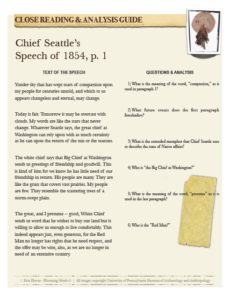
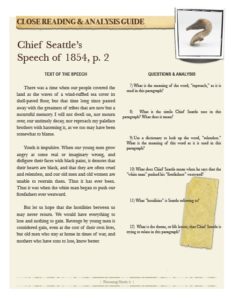
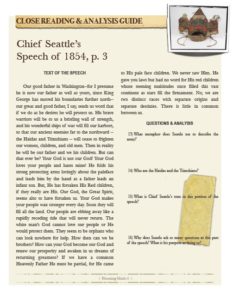
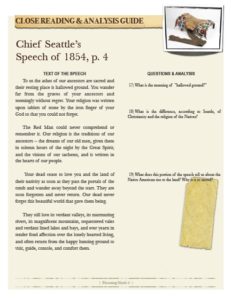
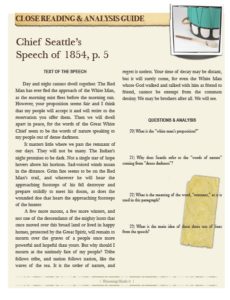
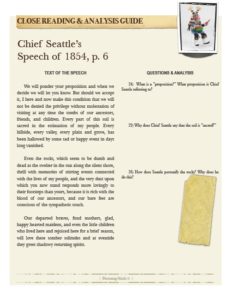
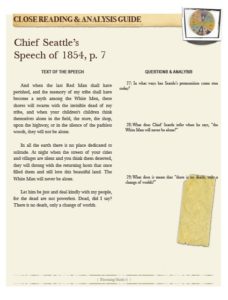
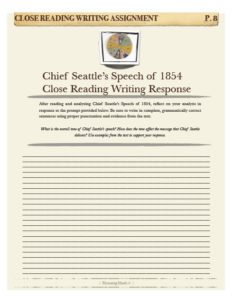
These standards are taken from the Common Core State Standards Initiative website: